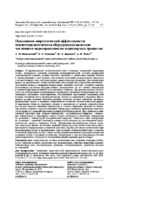| dc.contributor.author | Нияковский, А. М. | |
| dc.contributor.author | Романюк, В. Н. | |
| dc.contributor.author | Яцкевич, Ю. В. | |
| dc.contributor.author | Чичко, А. Н. | |
| dc.coverage.spatial | Минск | ru |
| dc.date.accessioned | 2019-04-03T12:20:30Z | |
| dc.date.available | 2019-04-03T12:20:30Z | |
| dc.date.issued | 2019 | |
| dc.identifier.citation | Повышение энергетической эффективности теплотехнологического оборудования на основе численного моделирования нестационарных процессов = Improving the Energy Efficiency of Heat-Technical Equipment on the Basis of Numerical Simulation of Non-Stationary Processes / А. М. Нияковский [и др.] // Энергетика. Известия высших учебных заведений и энергетических объединений СНГ. – 2019. – № 2. – С. 177-191. | ru |
| dc.identifier.uri | https://rep.bntu.by/handle/data/51353 | |
| dc.description.abstract | В промышленных теплотехнологических установках ускоренной гидратации бетона, являющихся основным элементом теплоэнергетической системы предприятий железобетонных изделий, режимы тепловой обработки и организация подвода теплоты к обрабатываемому в них изделию обусловлены требуемым распределением температур в объеме бетонного тела, обеспечивающим заданное качество продукции. Для оптимизации процессов, протекающих в таких теплотехнических устройствах, разработана математическая модель процесса твердения подвергаемого тепловой обработке бетонного изделия, позволяющая рассчитать пространственное распределение по его объему температуры и степени гидратации активной части цементного клинкера. Предлагаемая модель основывается на использовании нестационарного трехмерного уравнения теплопроводности, учитывающего внутренние тепловыделения, обусловленные протеканием экзотермической реакции в бетонном теле и предопределяющие степень его гидратации и твердения. Для заданного режима тепловой обработки методом конечных объемов выполнено численное моделирование процесса твердения симметричного бетонного объекта кубической формы. В выделенных точках исследуемого объекта в зависимости от времени термообработки рассчитаны скорости изменения температуры и степени гидратации, проведен их анализ. При анализе графиков скорости изменения температуры выявлены характерные перегибы, согласующиеся с заданным тепловым режимом работы нагревателя. При заданном режиме тепловой обработки вида «подъем температуры – изотермическая выдержка – понижение температуры» в выделенных точках объекта наблюдается увеличение температуры по сравнению с температурой изотермической выдержки. Отмечается сдвиг температуры по сравнению с заданным тепловым режимом работы нагревателя, обусловленный неравновесностью процесса твердения бетона. Предлагаемая математическая модель позволяет определять момент достижения заданной температуры для любой точки внутреннего пространства подвергающегося тепловой обработке изделия, что можно использовать при проектировании новых и модернизации существующих теплотехнологических установок ускоренной гидратации бетона, а также систем автоматизированного управления процессом твердения бетона в указанных устройствах. Полученные в ходе исследования результаты удовлетворительно согласуются с экспериментальными данными других авторов. | ru |
| dc.language.iso | ru | ru |
| dc.publisher | БНТУ | ru |
| dc.title | Повышение энергетической эффективности теплотехнологического оборудования на основе численного моделирования нестационарных процессов | ru |
| dc.title.alternative | Improving the Energy Efficiency of Heat-Technical Equipment on the Basis of Numerical Simulation of Non-Stationary Processes | ru |
| dc.type | Article | ru |
| dc.identifier.doi | 10.21122/1029-7448-2019-62-2-177-191 | |
| local.description.annotation | In industrial heat-technological installations for accelerated hydration of concrete, which are the main element of the thermal power system of enterprises of concrete products, the modes of heat treatment and the organization of heat supply to the product processed in them are due to the required temperature distribution in the volume of the concrete body, providing a given product quality. In order to optimize the processes occurring in such thermal device, a non-stationary mathematical model of the hardening process of the concrete product subjected to heat treatment has been developed, which allows calculating the spatial distribution of its volume temperature and degree of hydration of the active part of the cement clinker. The proposed model is based on the use of a non-stationary three-dimensional heat equation that takes into account the internal heat release due to the exothermic reaction in a concrete body and determines the degree of its hydration and hardening. For a given mode of heat treatment with the use of the finite volume method, numerical simulation of the hardening process of a symmetric concrete object of cubic shape is performed. In the selected points of the object under study, depending on the time of heat treatment, the rates of temperature change and the degree of hydration were calculated and their analysis was carried out. When analyzing the graphs of the temperature change rate, the characteristic inflections consistent with the given thermal mode of the heater were revealed. By a given mode of heat treatment of the form of “temperature rise – isothermal exposure – temperature decrease” in the selected points of the object there is an increase in temperature compared with the specified maximum temperatures of isothermal exposure, which is associated with the exothermic effect of the hydration reaction. A temperature shift relative to the specified thermal mode of the heater due to the non-equilibrium of the concrete hardening process is observed. The proposed mathematical model allows determining the time of reaching a preset temperature for any point of the internal space of the product subjected to heat treatment that can be used in the when designing of new and modernizing of existing thermal technological installations of accelerated hydration of concrete, as well as systems for automated control of the concrete hardening process in these devices. The results obtained during the study are in satisfactory agreement with the experimental data of other authors. | ru |

